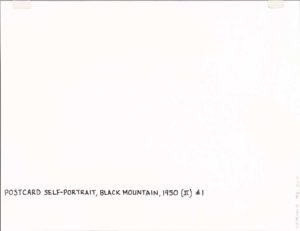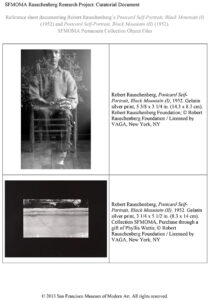Ownership History
San Francisco Museum of Modern Art, purchase through a gift of Phyllis Wattis, 1998
Exhibition History
Robert Rauschenberg: The Early 1950s, Corcoran Gallery of Art, Washington, D.C., June 15–August 11, 1991. Traveled to: The Menil Collection, Houston, September 27, 1991–January 5, 1992; Museum of Contemporary Art, Chicago, February 8–April 19, 1992; San Francisco Museum of Modern Art, May 14–August 16, 1992; Guggenheim Museum SoHo, New York, October 24, 1992–January 24, 1993.
Robert Rauschenberg: A Retrospective, Solomon R. Guggenheim Museum, New York, September 19, 1997–January 7, 1998. Traveled to: The Menil Collection, Houston, February 13–May 17, 1998; Museum Ludwig, Cologne, Germany, June 27–October 11, 1998; Guggenheim Museum Bilbao, Spain, November 21, 1998–March 7, 1999.
Robert Rauschenberg, San Francisco Museum of Modern Art, May 7–September 7, 1999.
Robert Rauschenberg at SFMOMA, San Francisco Museum of Modern Art, June 27–September 8, 2002 (on view June 27–July 30, 2002).
Black Mountain College: Una aventura americana, Museo Nacional Centro de Arte Reina Sofía, Madrid, October 28, 2002–January 13, 2003.
Treasures of Modern Art: The Legacy of Phyllis Wattis at SFMOMA, San Francisco Museum of Modern Art, January 30–June 24, 2003.
75 Years of Looking Forward: The Anniversary Show, San Francisco Museum of Modern Art, December 19, 2009–January 16, 2011.
In addition to appearing in the special exhibitions listed above, Postcard Self-Portrait, Black Mountain (II) was shown in SFMOMA’s galleries in 2002 and 2009 as part of a series of rotating presentations of the permanent collection.
This listing has been reviewed and is complete as of August 31, 2016.
Publication History
Walter Hopps, Robert Rauschenberg: The Early 1950s (Houston: Menil Foundation and Houston Fine Art Press, 1991), 62, 69 (ill.).
———, Robert Rauschenberg: The Early 1950s (Houston: Menil Foundation, 1991), 32. Exhibition booklet produced for the Menil presentation only.
Fred Camper, “The Unordered Universe,” Chicago Reader, March 26–April 1, 1992, 31.
Christos M. Joachimides and Norman Rosenthal, eds., American Art in the 20th Century: Paintings and Sculpture, 1913–1993 (Munich: Prestel Verlag, 1993), 94 (ill.); (German edition: Munich: Prestel Verlag, 1993), 118 (ill.).
Walter Hopps and Susan Davidson, eds., Robert Rauschenberg: A Retrospective (New York: Solomon R. Guggenheim Museum, 1997), 55 (ill.).
Joan Seeman Robinson, “Disappearing Act: Robert Rauschenberg,” Spot 17, no. 2 (Fall 1998): 12–13 (ill.).
Vincent Katz, ed., Black Mountain College: Experiment in Art (Cambridge, MA: MIT Press, 2002), 158 (ill.).
Branden W. Joseph, “The Gap and the Frame,” October 117 (Summer 2006): 60, 61 (ill.), 62–63.
Janet Bishop, Corey Keller, and Sarah Roberts, eds., San Francisco Museum of Modern Art: 75 Years of Looking Forward (San Francisco: San Francisco Museum of Modern Art, 2009), 432.
Nicholas Cullinan, Robert Rauschenberg: Photographs 1949–1962, ed. Susan Davidson and David White (New York: Distributed Art Publishers, 2011), 93 (ill.).
Ralf Beil and Peter Kraut, eds., A House Full of Music: Strategies in Music and Art (Darmstadt, Germany: Institut Mathildenhöhe, 2012), 35 (ill.).
Amy Knight Powell, Depositions: Scenes from the Late Medieval Church and the Modern Museum (New York: Zone Books, 2012), 226, 227 (ill.), 228–33.
This listing has been updated since the launch of the Rauschenberg Research Project and is complete as of August 31, 2016.

